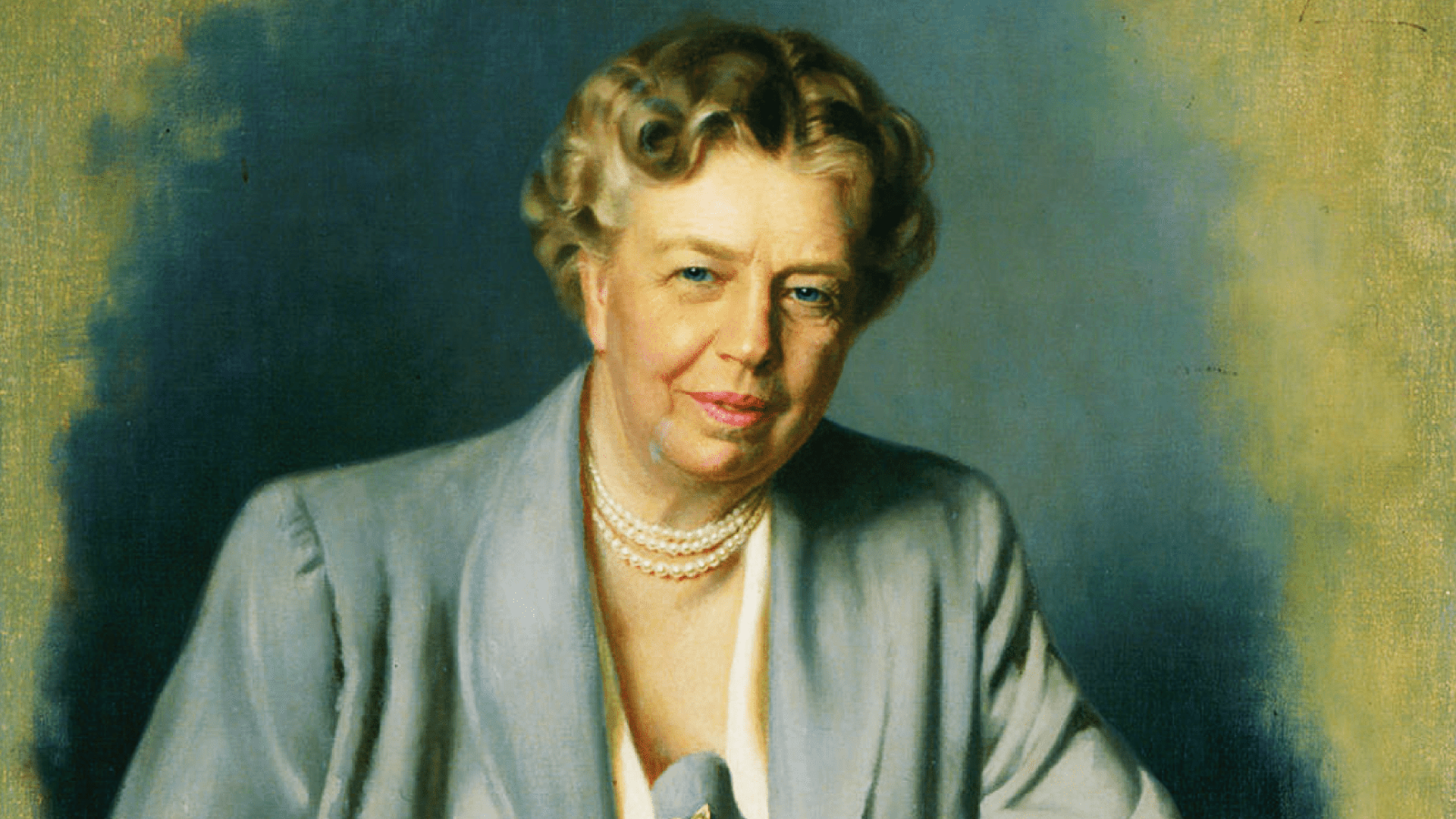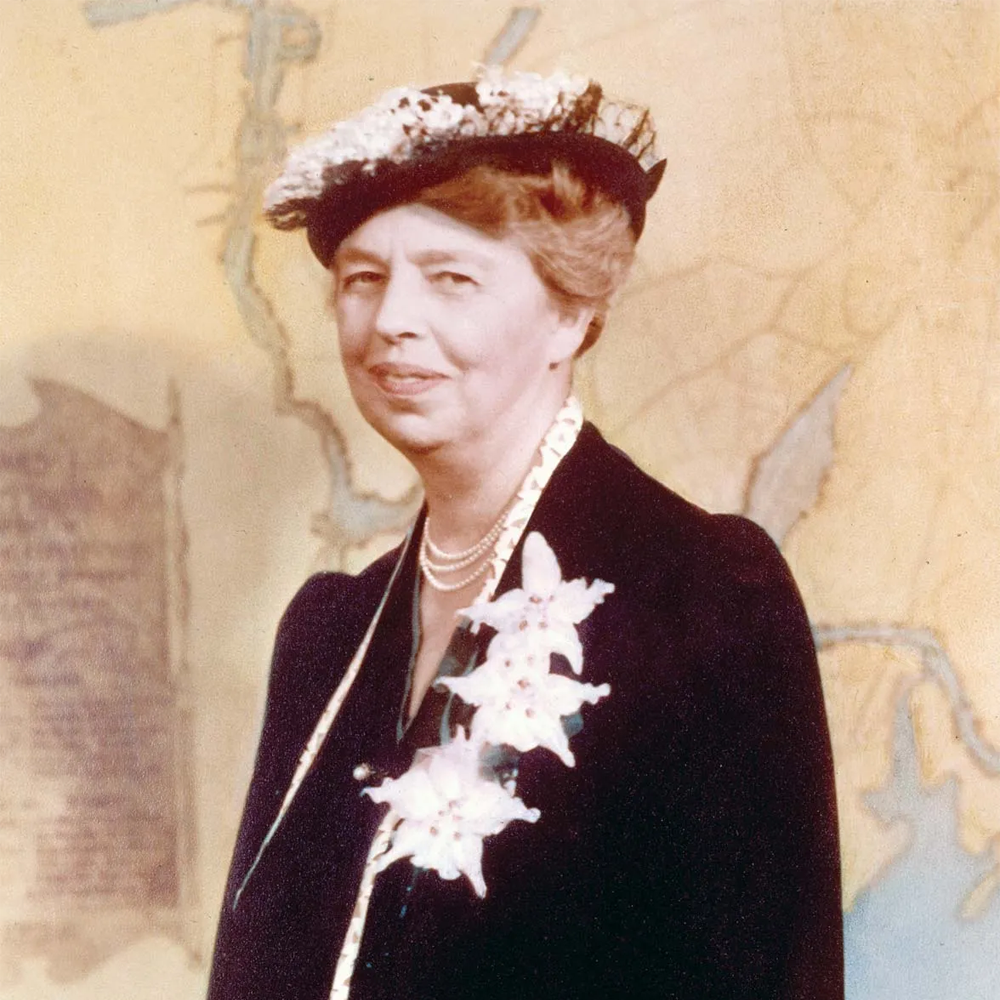Eleanor Roosevelt

Illustrated portrait of Eleanor Roosevelt holding the Universal Declaration of Human Rights, with justice scales in the background.
Biography
Born in 1884 into the powerful Roosevelt family, Eleanor Roosevelt’s early life looked golden on the outside—but inside, it was marked by deep personal loss. By age ten, she had lost both parents and one of her brothers. Raised by a strict grandmother, Eleanor’s self-confidence was fragile, until her time at Allenswood Academy in London, where teacher Marie Souvestre ignited her political awakening.
Eleanor married her distant cousin Franklin D. Roosevelt in 1905 and, for a while, played the role expected of her. But life had other plans. As she navigated the world of Washington politics, volunteered during World War I, and supported FDR through his polio diagnosis in 1921, Eleanor found her own voice. By the 1920s, she wasn’t just the president’s wife, she was a headline-making activist in her own right, challenging the limits placed on women in public life.
As First Lady from 1933 to 1945, she didn’t just host dinners. She redefined the job. Eleanor traveled the country to see how the New Deal was (or wasn’t) working. She wrote daily columns, held press conferences for women reporters, and fought for voices excluded from power — especially women, Black Americans, the poor, and immigrants.
She publicly resigned from the Daughters of the American Revolution when they refused to let Black opera singer Marian Anderson perform. She pushed FDR to appoint the first female Cabinet member, Frances Perkins. She demanded justice for striking miners, protested housing discrimination, and championed civil liberties long before it was politically popular.
After FDR’s death, she didn’t retire, she went global. As a delegate to the United Nations, she chaired the Human Rights Commission and helped draft one of the most important documents of the 20th century: the Universal Declaration of Human Rights. Later, she chaired JFK’s Presidential Commission on the Status of Women and worked on the Equal Pay Act of 1963.
Until her death in 1962, Eleanor Roosevelt kept writing, speaking, organizing, and inspiring. Her syndicated column, 'My Day,' ran for 27 years. She was nicknamed 'First Lady of the World' for a reason. She didn’t just advocate for a better America, she demanded a better world.
Eleanor Roosevelt didn’t inherit her power, she built it. And then she used it relentlessly for others. At a time when women were expected to stay quiet and ornamental, she became the conscience of the presidency and a global symbol of justice. She challenged racism, sexism, and poverty not just with words, but with action — resigning from elite organizations, challenging FDR directly, and traveling to war zones to boost morale. Her work on the Universal Declaration of Human Rights still shapes international law today. She reminds us that titles and privilege mean nothing without purpose—and that real leadership means showing up, listening deeply, and refusing to back down when human dignity is on the line.
?
How did Eleanor Roosevelt use her privilege to help those without it?
Why was her work on the Universal Declaration of Human Rights so significant?
In what ways did Eleanor Roosevelt challenge expectations for women in politics?
How do leaders today continue—or fail—to live up to Roosevelt’s legacy?
What can young people learn from Roosevelt about using their voice and platform?
Dig Deeper
An inspiring look at Eleanor Roosevelt’s evolution from shy socialite to fierce advocate for justice and global peace.
Eleanor Roosevelt dedicated her life to fighting for the rights of the oppressed and forgotten, including her signature achievement: pushing FDR to set up the National Youth Administration.
Discover more

Franklin Delano Roosevelt
Franklin D. Roosevelt led the United States through the Great Depression and World War II, reshaping the presidency, expanding the federal government, and laying the foundation for the modern welfare state.

Sojourner Truth
Sojourner Truth was a formerly enslaved woman who became one of the most powerful voices in American history for abolition, women’s rights, and racial justice.

Nelson Mandela
Nelson Mandela was a South African freedom fighter who spent 27 years in prison for resisting apartheid and became the country’s first Black president.
Further Reading
Stay curious!
